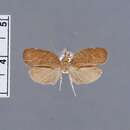Comprehensive Description
provided by Smithsonian Contributions to Zoology
Gonionota aethoptera
Alar expanse 24–25 mm.
Labial palpus light cinnamon brown; second segment with gray apical annulus; third segment suffused gray, apex buff. Antenna light cinnamon brown with faint grayish annulations; scape buff ventrally. Head light cinnamon brown mixed with gray in lateral scale tufts. Thorax light cinnamon brown, scales of crest tipped with dark brown. Forewing ground color light cinnamon brown; scattered gray scales along fold to tornus and irregularly in apical half; termen narrowly blackish from vein 4 to tornus; at apical third of costa a small white spot; at basal third, in cell, two black spots; at end of cell a conspicuous white spot; dorsum with conspicuous dark brown streak; cilia light cinnamon brown. Hindwing light ocherous tawny overlaid with gray scales; cilia pale grayish. Foreleg ocherous white; femur, tibia, and first tarsal segment overlaid light cinnamon tawny; midleg ocherous white with dark gray shade on tibia; tarsal segments yellowish; hindleg ocherous white with grayish suffusion and spots on tibia; tarsal segments yellowish. Abdomen ocherous white, suffused grayish dorsally.
Male genitalia slide JFGC 12113. Harpe broadest basally, gently narrowed toward the rounded cucullus; sacculus broadly sclerotized to slightly beyond middle and terminating in a large setose protuberance. Gnathos a narrow, transverse, oval spined knob. Uncus very narrow basally terminating in widely divergent arms. Vinculum a narrow band. Tegumen rather broad, convex laterally, shorter than harpe. Anellus a very strongly sclerotized, subrectangular plate with a narrow dentate projection posteriorly at each corner. Aedeagus very stout, curved, distally shovel shaped; vesica armed with two sclerotized plates each bearing a cluster of stout cornuti.
Female genitalia slide JFGC 12060. Ostium V-shaped, laterally strongly sclerotized. Antrum a very narrow sclerotized ring. Inception of ductus seminalis at dorsoanterior edge of antrum. Ductus bursae membranous with very finely granular surface, the granular surface continuing as a narrow band to anterior third of the membranous bursa copulatrix. Signum an elongate, sclerotized, dentate plate. Lamella antevaginalis narrow, sclerotized. Lamella postvaginalis membranous with granular surface.
HOLOTYPE.—USNM 71083.
TYPE LOCALITY.—Venezuela, Aragua, Rancho Grande, 1100 m.
DISTRIBUTION.—Venezuela.
Described from the holotype, one and 3 paratypes all from the same locality as holotype and with following dates, etc., (16–23. X. 66); (24–31. X. 66), (1–5. XI. 66) all collected by S. S. and W. D. Duckworth; (19. VI. 67), (22–31. VII. 67), both collected by R. W. Poole.
Under cologramma I have pointed out that aethoptera and several other species are related to it, but aethoptera is a considerably larger moth than cologramma, is generally darker in color, with a much darker hindwing.
- bibliographic citation
- Clarke, J. F. Gates. 1971. "Neotropical Microlepidoptera XIX: notes on and new species of Oecophoridae (Lepidoptera)." Smithsonian Contributions to Zoology. 1-39. https://doi.org/10.5479/si.00810282.95
Gonionota aethoptera: Brief Summary
provided by wikipedia EN
Gonionota aethoptera is a moth in the family Depressariidae. It was described by John Frederick Gates Clarke in 1971. It is found in Venezuela.
The wingspan is 24–25 mm. The forewings are light cinnamon brown with scattered grey scales along the fold to the tornus and irregularly in the apical half. The termen is narrowly blackish from vein 4 to the tornus and there is a small white spot at the apical third of the costa and at the basal third, in the cell, are two black spots. At the end of the cell is a conspicuous white spot and the dorsum has a conspicuous dark brown streak. The hindwings are light ocherous tawny overlaid with grey scales.
- license
- cc-by-sa-3.0
- copyright
- Wikipedia authors and editors

